
At the age of 3, while playing in his father's shop, Louis injured his eye on a sharp tool.
Despite the best care available at the time, infection set in and soon spread to the other eye as well, leaving him completely blind.
Fortunately, Louis' parents, together with the local priest and school teacher, were alert to his superior learning abilities and eager to provide him with the opportunity to develop them to the fullest extent possible.
So, when Louis became of school age, he was allowed to sit in the classroom to learn what he could by listening. Despite an initial assumption that his handicap would keep him well back of the other pupils, he was soon leading the class.
At the extraordinarily young age of ten, Louis was sent on scholarship to the Royal Institution for Blind Youth in Paris.
There too, most instruction was oral, although there were some books in a raised-print system developed by the school's founder, Valentin Haüy.
Once again, the diligent Louis did well at his studies, and moreover developed a considerable talent for music, first at the piano and then at the organ.
The general idea of a tactile alphabet that would allow blind persons to read and write also began to take shape in his mind at this time.
It was a French army captain, Charles Barbier de la Serre, who actually invented the basic technique of using raised dots for tactile writing and reading.
His original objective was to allow soldiers to compose and read messages at night without illumination.
Barbier later adapted the system and presented it to the Institution for Blind Youth, hoping that it would be officially adopted there.
He called the system Sonography, because it represented words according to sound rather than spelling.
While the Institution accepted Sonography only tentatively, Louis set about using and studying it with his customary intensity.
Soon he had discovered both the potential of the basic idea and the shortcomings in some of Barbier's specific provisions, such as a clumsy 12-dot cell and the phonetic basis.
Within three years, by age 15, Louis had developed the system that we know today as braille (see next section), employing a 6-dot cell and based upon normal spelling.
He also went on to lay the foundations of the braille representation of music, and in 1829 published the Method of Writing Words, Music and Plain Song by Means of Dots, for Use by the Blind and Arranged by Them.
Although Louis Braille went on to become a loved and respected teacher, was encouraged in his research, and remained secure in his own mind as to the value of his work, his system of touch reading and writing was nevertheless not very widely accepted in his own time.
Louis Braille died on January 6, 1852. In the years that followed, the practicality as well as simple elegance of his braille system was increasingly recognized, and today, in virtually every language throughout the world, it is the standard form of writing and reading used by blind persons.
If a blind child is taught braille skills with the same sense of importance that is rightly attached to the teaching of print skills to sighted children, he or she will grow up able to read at speeds comparable to print readers, a life skill of inestimable value.
Over 150 years after Louis Braille worked out his basic 6-dot system, its specific benefits remain unmatched by any later technology -- though some, computers being a prime example, both complement and contribute to braille.
I Bow My head to respect a Real Man of Inspiration
who inspired me in an unique way.
Prayer to the Almighty!
Oh! God! The Almighty!
Please Make me more worthy so that Many can get inspired & strengthened while looking at me.
Make me useful unto others.
Make me work & earn more so that I can give more to the need.
With Tons Of Love & Gratitude
+VE Anthony Muthu
+ve Anthony Muthu,
Anthony Muthu,
Positive Mind Power,
Self Confidence,
Self Improvement,
Super Mind,
The Law of Attraction

on 12 April, 2008 18:07
Good post Antony....Keep up the spirit!!
anbudan aruna
Post a Comment